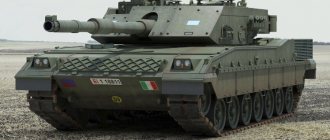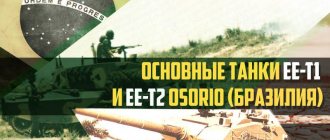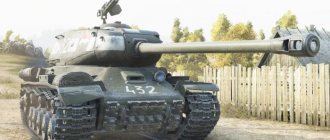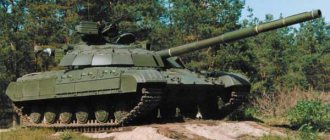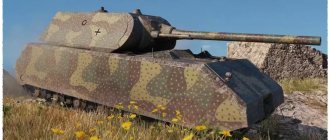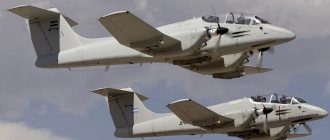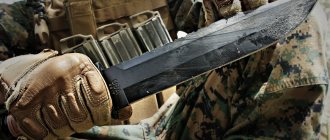History of creation
By 1976, the Type 61 and Type 74 main tanks that existed in Japan were very outdated, and it was decided to create a combat vehicle that would be equal in strength to the Soviet T-72. Mitsubishi began work on a new tank, attracting specialists from Germany who worked on the Leopard. As a result, by 1989 the tank was developed, received the index “90” and sent for testing. German features were clearly visible in his appearance.
During the development of the tank, a fire control system was created, one of the best in the world. It includes panoramic devices stabilized in two planes, observation and guidance devices, a laser range finder, an electronic ballistic computer and many other devices and sensors that significantly simplify the process of targeting a target.
After all the tests, a pilot batch was released in 1990, and in 1992 mass production of the Type 90 main tank began.
Today, the Type 90 tank is no longer produced - the cheaper-to-produce and more modern Type 10 is used. As of 2016, 341 Type-90s are in service.
During all this time, the tank was never delivered abroad and never took part in hostilities.
gun
In terms of combat equipment and firepower, our self-propelled gun is a real average, now you will understand what we are talking about.
Ikv 90 B gun
It has an alpha strike that is not at all record-breaking, but not bad by the standards of its classmates, and a quite tolerable rate of fire; it is capable of inflicting approximately 2030 units of damage per minute, excluding the rammer and perks.
The armor penetration characteristics of the vehicle are good, basic armor-piercing shells are enough even to fight the ninth levels, but being at the bottom of the list on Ikv 90 Typ B World of Tanks
you will have to target weak spots in the enemy’s armor. You can’t call it a gold-dependent tank destroyer, but for greater comfort it doesn’t hurt to carry about 10 cumulative shells with you.
As for accuracy, everything is average here again. We have good accuracy, which is expressed in a small spread, moderately fast convergence and weak stabilization. But more importantly, the Ikv 90 B WoT tank
received very excellent UVN and UGN. We are able to lower the gun 10 degrees down, and the horizontal aiming angle is a total of 40 degrees (20 in each direction), it is very convenient to fight with such indicators.
TTX
general information
- Classification – main battle tank;
- Weight – 50.2 tons;
- The layout is classic;
- Crew – three people;
- Years of production – 1990-2012;
- Years of operation – since 1992.
Dimensions
- Length including gun – 9775 millimeters;
- Case width – 3430 millimeters;
- Height – 2340 millimeters;
- Ground clearance is an average of 450 millimeters.
Booking
- Type of armor – projectile-resistant, modular composite.
Armament
- Caliber and brand of gun – 120 mm Rheinmetall L44;
- Gun type – smoothbore;
- Barrel length - 44 calibers;
- Ammunition – 45;
- HV angles: −12…+15°;
- Machine guns - 1 × 7.62 mm Type 74, 1 × 12.7 mm M2.
Mobility
- Engine type – 10ZG;
- Power – 1500 horsepower;
- Highway speed – 60-65 km/h;
- Cruising range on the highway – 300 kilometers;
- Specific power – 29.9 hp/t;
- Suspension type – hydropneumatic, active;
- The wall to be overcome is 1 meter;
- The ditch to be overcome is 2.7 meters;
- The ford that can be overcome is 2 meters.
Design description[edit]
Type 90 on the side.
The tank has a classic layout, with the control compartment located in the frontal part, the fighting compartment in the middle and the engine compartment in the rear. Unlike the vast majority of Western main battle tanks, the Type 90 is equipped with an automatic loader, which made it possible to reduce its crew to three people - driver, gunner and commander. The driver is located on the left. The tank commander is located on the right, and the gunner on the left, each of them has a separate hatch for embarkation/disembarkation. In general, the tank in its design resembles the Leopard 2 tank, some sources mention that German engineers also took part in the process of creating the tank, so in terms of armor the tank is in most parts similar to the Leopard 2 modification A4.
Firepower[edit]
Fire control system and sighting devices[edit]
Type 90 sighting devices.
The Type 90 tank's fire control system provides automatic tracking and round-the-clock engagement of targets on the move. A modern OMS includes:
- gunner's periscope sight (daytime optical channel, thermal imaging channel on two monitors and aluminum-yttrium laser rangefinder);
- commander's periscope sight stabilized in two planes (manufactured by Fuji Photo Optical Company);
- 32-bit ballistic computer;
- automated firing system;
- two-plane gun stabilizer.
The following systems are installed on the commander's seat:
- daytime periscope sight with a magnification of 3-10x manufactured by Nikon Corporation has a vertical viewing angle: +/-29° and a horizontal viewing angle +/-90°;
- monitor with a thermal imaging channel of the gunner's sight manufactured by Fujitsu Company.
Laser rangefinder characteristics:
- Range: 300 to 5000 m;
- Daily gain: from 1 to 10 times;
- Night gain: from 3 to 10 times.
Weapons[edit]
Firing from the Type 90.
The main armament of the tank is a licensed 120-mm Rheinmetall smoothbore gun, which has a barrel length of 44 calibers and is equipped with an automatic loader. The gun is equipped with a powder gas ejector, a thermal casing and is stabilized in two planes. The same gun is installed on the American M1 Abrams tank and the German Leopard 2. Before the Rheinmetall guns were selected, the Japanese mastered the production of the domestic 120 mm tank gun, but the lower price of the L44 became decisive when choosing the Type 90 gun. The gun's ammunition capacity is 45 shots, 20 of which are placed in the automatic loader.
The tank's gun is equipped with an automatic loader located in the rear of the turret, which makes it possible to exclude the loader from the crew. In this, the Type 90 follows the Soviet T-64, T-72, T-80, T-90, as well as the French Leclerc and the Swedish Stridsvagn 103 tank destroyer.
Auxiliary weapons
- Anti-aircraft 12.7 mm M2HB machine gun (660 rounds of ammunition);
- Coaxial with a 7.62 mm Type 74 cannon (2000 rounds of ammunition).
Security and survivability[edit]
Armored hull and turret Type 90.
The tank is equipped with systems for high-speed automatic fire extinguishing and protection against weapons of mass destruction.
Ballistic protection[edit]
The tank's hull and turret are welded. The tank's armor protection is differentiated. The armor in the frontal part of the hull and turret is multi-layered and combined. Protection of the sides of the hull and turret can be enhanced through removable modules with spaced armor.
Active protection[edit]
The Type 90 is equipped with a smoke (aerosol) screen system to counter guided missiles with laser homing or semi-automatic laser beam guidance, as well as interfering with the operation of laser rangefinders and smoke (aerosol) screen installation. The tank has a deforming color. Measures have also been taken to reduce noise, exhaust smoke and visibility in the infrared range.
Mobility[edit]
Operation of the active suspension on the Type 90.
Engine and transmission[edit]
Type 90 is equipped with a V-shaped ten-cylinder two-stroke Mitsubishi 10ZG liquid-cooled diesel engine with direct injection, turbocharger and heat exchanger. Engine power is 1500 hp. s., which allows the tank to travel 200 meters from a standstill in 20 seconds. The capacity of the fuel tanks is 1100 liters.
The tank's automatic transmission has 4 forward and 2 reverse gears. The Type 90 is equipped with a helm-based control and a comprehensive motion control system.
Chassis[edit]
The chassis is six-wheel and equipped with support rollers. The suspension is combined (adjustable hydropneumatic on the outer nodes, torsion bar on the rest). The standard ground clearance is 450 mm, and can vary from 200 to 600 mm. The tank's tracks are asphalt tracks, with a rubber-metal hinge.
Ergonomics[edit]
- Automatic gear shifting greatly simplifies control, reduces driver training time and reduces fatigue during long-term driving of the tank;
- Driver's on-board computer.
Type 90 based vehicles
Several vehicles were created based on the Type 90:
- BREM 90 - Armored repair and recovery vehicle. It had a hull superstructure with a crane, bulldozer and hydraulic winch;
- Technical support vehicle Type 90 (in Japan it is acceptable for different vehicles to have the same index);
- Type-91 bridge-laying tank, capable of covering an obstacle up to 20 meters with a bridge with a lifting capacity of 60 tons.
BREM 90 (right) is used for “changing shoes” Type 10
Bridgelayer Type 91 in operation
TTX Ikv 90 Typ B
We will begin, as usual, with the fact that this unit has a modest, as is customary in the ranks of tank destroyers, margin of safety and a very small basic viewing range of 350 meters for the seventh level.
Regarding survivability, these Ikv 90 B characteristics
They have both a frankly weak side and a strong one. First of all, looking at the dry numbers and taking into account the data from the vehicle model, we can say with confidence that no matter how you look at it, it seems that this self-propelled gun is made of cardboard. Everyone will penetrate us, and artillery cases and landmines flying from large-caliber guns (in 99% of cases with full damage) will send you to the hangar more than once after the first hit.
The strong point is that the Ikv 90 Typ B is a Swedish tank
is the owner of small body dimensions and a very squat silhouette, thanks to which it is not so easy to hit us, and the stealth factor here is very good.
Continuing the topic of positive aspects, we cannot help but say that the Ikv 90 B tank destroyer
there is good mobility. The car boasts an excellent maximum speed, very decent dynamics, and only the turning speed of the chassis is slightly let down, so beware of moving enemies, they can spin you.
Machine Analysis
According to experts, the Type 90 tank had the following advantages and disadvantages.
Advantages
- Innovative fire control system, unique and extremely convenient. It allows the crew to quickly make accurate decisions without being distracted from controlling the tank;
- Very high specific power - 29.9 compared to 21.5 for the Russian T-90 or 24 for the German Leopard 2A6M;
- An automatic loader has been added, due to which the crew has been reduced to three people, and the rate of fire has been significantly increased.
Flaws
- Too expensive;
- The large number of complex electronics made the tank extremely labor-intensive to produce;
- Due to the two-stroke engine, it consumes fuel quickly;
- No auxiliary power unit.
Type 90 in winter camouflage
You can often see that the Type 90 in various ratings is considered one of the ten or even five best main tanks in the world. Of course, there are reasons for this, but we should not forget that the tank never took part in battles either in Japan or abroad. So all comparisons and assumptions are based only on the experience of the exercises, and it is unknown how the Type 90 would perform in real combat.
Content
- 1 History of creation and production
- 2 Design description 2.1 Firepower 2.1.1 Fire control system and sighting devices
- 2.1.2 Armament
- 2.2.1 Ballistic protection
- 2.3.1 Engine and transmission
- 3.1 Advantages
Advantages and disadvantages
Considering all of the above, we can draw a simple conclusion - this tank destroyer is quite balanced, it has a number of really strong points, but there are also a lot of disadvantages. However, to fully understand the playing style of the Ikv 90 B World of Tanks
, it is better to highlight the advantages and disadvantages separately.
Pros: • Excellent mobility (maximum speed and dynamics); • Small size and very good camouflage; • Not a bad alpha strike and decent DPM; • Good armor penetration parameters; • Comfortable UVN and UGN. Cons: • Frankly weak armor; • Small margin of safety; • Poor visibility; • We are slightly lacking in accuracy.
